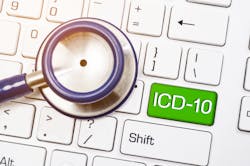Symptom-specific ICD-10 codes lack sensitivity and have poor negative predictive value (NPV) for characteristic COVID-19 symptoms, according to new research published in JAMA Network Open. The codes fared better when they were capturing specificity and positive predictive value (PPV), the data showed.
Researchers compared the performance of International Classification of Diseases and Related Health Problems, Tenth Revision (ICD-10) codes for fever, cough, and shortness of breath with the electronic medical records (EMRs) of 2,201 patients tested for COVID-19 infection at University of Utah Health from Mar 10 to Apr 6. ICD-10 codes are often used for data aggregation and analysis, the researchers noted.
Medical records showed that 1,444 of the 2,201 patients—or 66 percent—had fever, while 1,930 (88 percent) had cough, and 1,399 (64 percent) had shortness of breath. However, the sensitivity—or the ability to identify those with a condition—of ICD-10 codes for fever was just 26 percent. Meanwhile, the specificity—the ability to identify those without a condition—was 98 percent and the positive predictive value —the likelihood that those who test positive for a disease truly have it—was 96 percent.
Further, the NPV—the likelihood that those who test negatively truly don't have a disease—was 41 percent. In general, the higher the percentage for these tests, the more reliable they are, with 90 percent or higher considered a good score, the researchers noted.
Meanwhile, sensitivity for cough was 44 percent, while specificity was 88 percent; PPV was 96 percent, and NPV was 18 percent. For shortness of breath, sensitivity was 24 percent, specificity was 97 percent, PPV was 93 percent, and NPV was 42 percent. ICD-10 performance was better for hospitalized patients than for those in the outpatient setting for fever and shortness of breath but not cough, the researchers stated.
The researchers wrote that high false-negative rates were the main contributor to poor ICD-10 code performance. The proportion of patients with a false-negative ICD-10 code result ranged from 35.8 percent for fever among patients older than 64 years to 54.5 percent for fever among patients who tested positive for SARS-CoV-2 infection.
The authors called for "meticulous data validation to feed multicenter registries built from EMRs" to generate accurate, reliable research results.
The researchers concluded, “These findings suggest that symptom-specific ICD-10 codes do not accurately capture COVID-19–related symptoms and should not be used to populate symptoms in electronic medical record–based cohorts.”
They then added, “Symptoms are an essential part of data collection for SARS-CoV-2 and COVID-19 surveillance and research, but symptom-specific ICD-10 codes lack sensitivity and fail to capture many patients with relevant symptoms; the false-negative rate is unacceptably high. Common data models and other aggregation tools rely heavily on ICD-10 codes to capture clinical concepts; inaccuracy has implications for any downstream scientific discovery or surveillance.”

